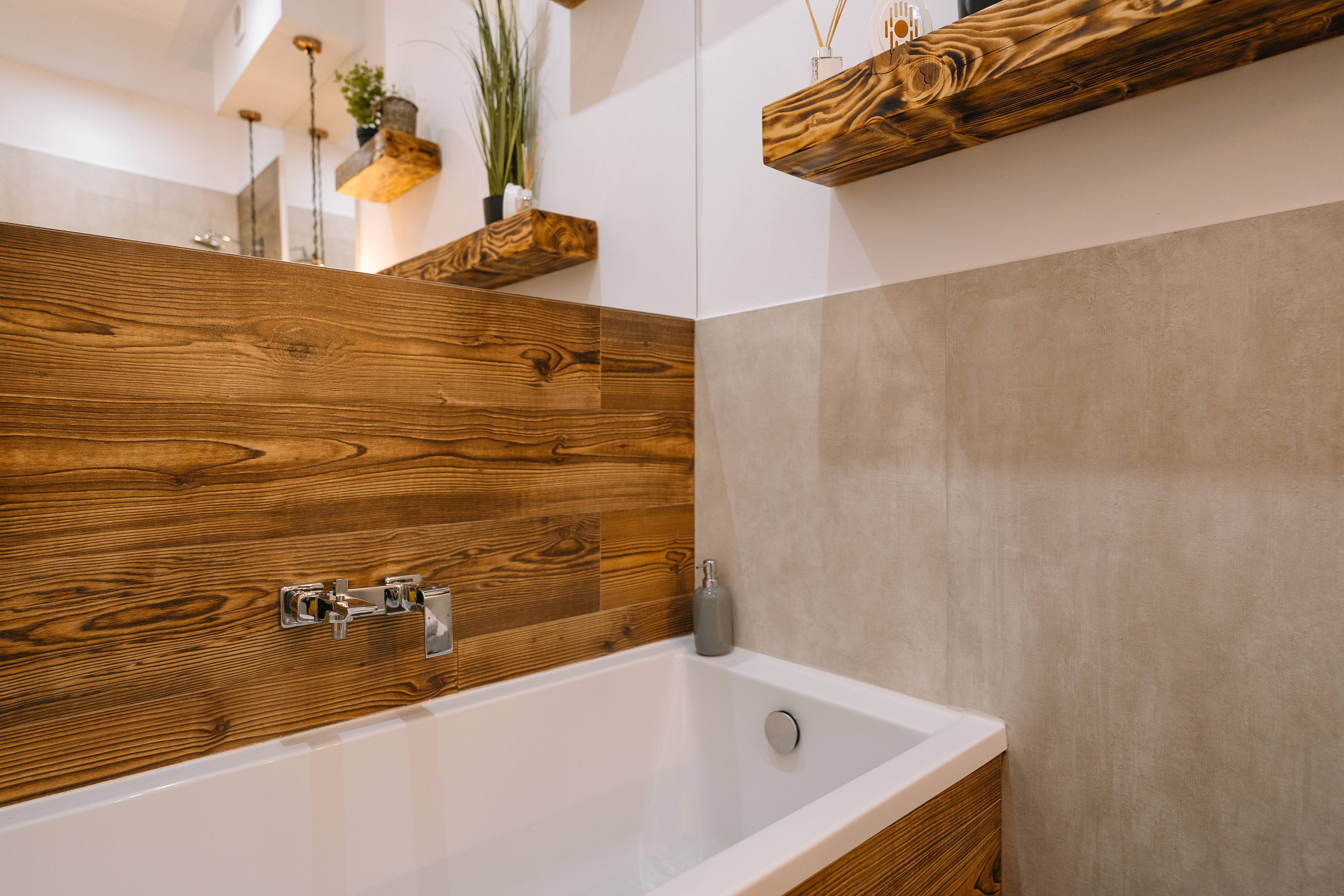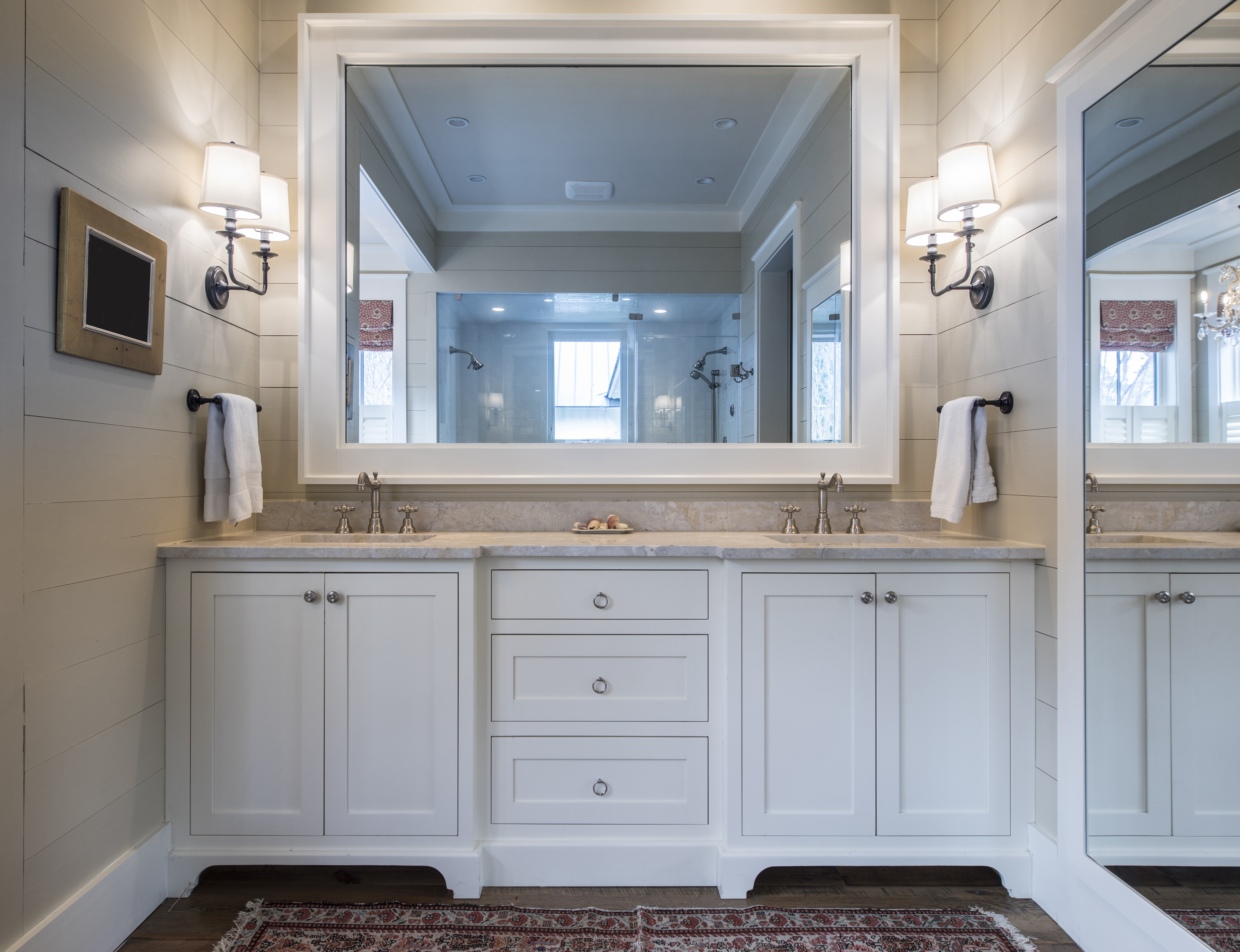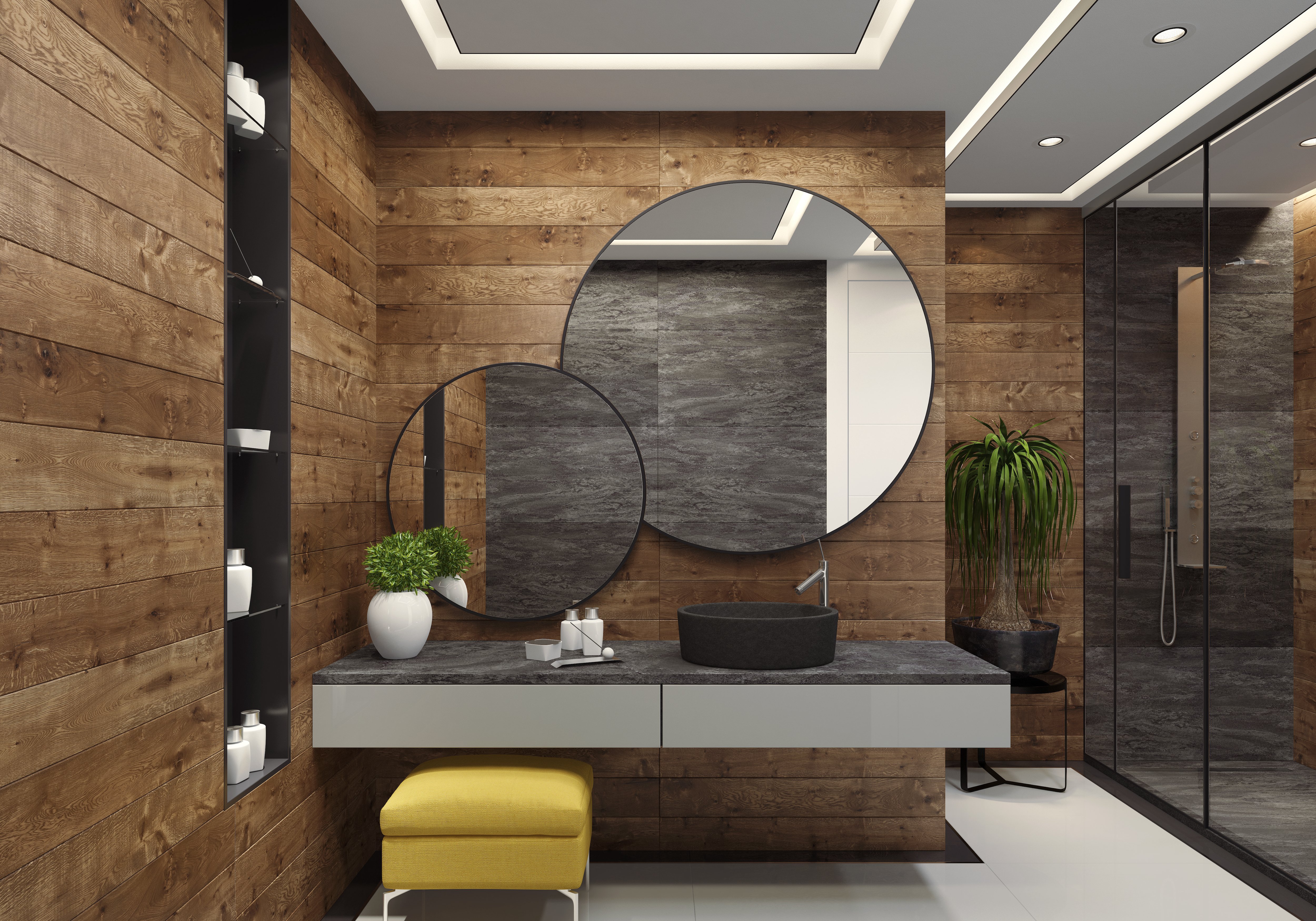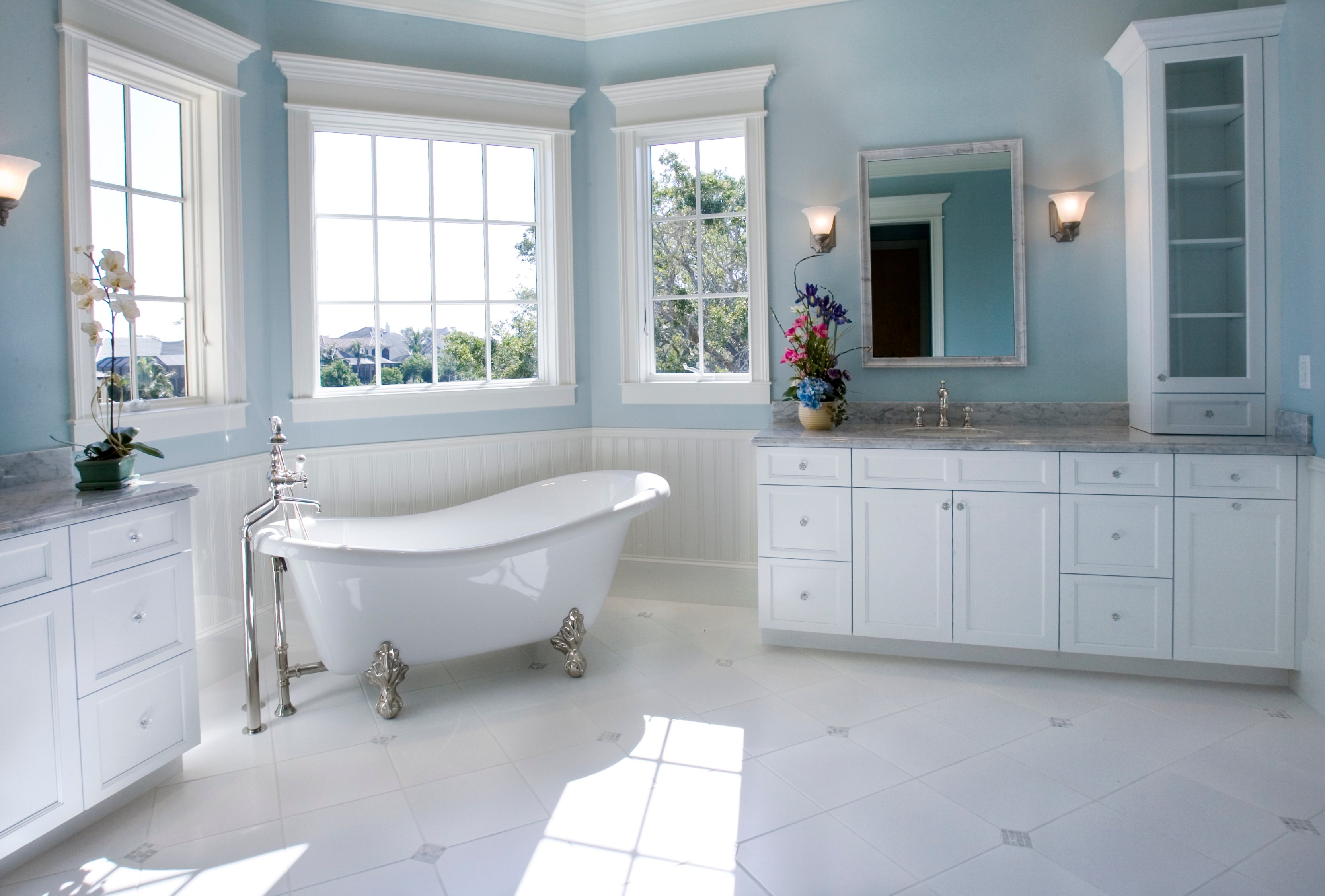
Remodeling your bathroom can add significant value to your home. Your bathroom remodel cost in Columbus, OH will depend on size, fixtures, materials, labor, and other factors.
Because you shouldn't just put it anywhere


Avoid adding shiplap to wet areas, like a shower wall, or you could see warping and mold.
Mildew-resistant paint and wood protectant can help keep your shiplap in good shape.
You can mimic the look of shiplap with faux options that aren’t as vulnerable to water.
Shiplap costs $2.50 to $7 per square foot, but overall costs depend on the size of your bathroom.
With its clean lines, rustic charm, and ability to instantly update a room without breaking the home renovation budget, it’s no wonder that shiplap is everywhere. But should it be? Specifically, is it okay to add shiplap to a bathroom where high moisture and humidity levels occur?
Whether you’ve scoured the internet for modern farmhouse design ideas or watched enough home improvement TV shows, you’ve seen shiplap bathrooms. And they can absolutely be done, as long as you take a few precautions.
Because shiplap is a type of wood paneling, avoid placing it in areas that are frequently exposed to water, such as a shower wall or ceiling. When wood gets wet, it can swell, warp, and sag and develop mold and mildew.
The problem becomes more complicated when you want a sink backsplash or an accent wall by a standalone tub. The shiplap will undoubtedly get wet occasionally—especially if you have young kids—but it won’t be in frequent contact with water. If you’re unsure where to add shiplap in a bathroom, speak with a local bathroom designer who can help you balance all the design elements while sticking to your budget.
To protect your shiplap boards against the occasional splash of water, apply a coat of mold- and mildew-resistant paint. These paints are designed for bathrooms and other high-moisture environments and can effectively repel water.
You can apply a clear coat of wood sealer on top of the paint for additional protection. Alternatively, you can forgo the paint and use a clear sealer for a wood-shiplap look.
We also recommend applying some sort of wood protectant to all the shiplap in your bathroom, even if you’re installing it far away from your water sources, such as on the ceiling. That’s because bathrooms are prone to humidity, which can still wreak havoc on your wood.
The exception to this would be if you are doing a shiplap bathroom ceiling in a powder room with only a sink and toilet. Without a shower, the bathroom shouldn’t get hot and steamy, so moisture resistance will be less of a concern.
To extend the life of your shiplap, keep your bathroom ventilated. That means installing a bathroom fan and using it while showering. And it means opening the bathroom door—and windows if possible—to let steam escape. It’s worth spending a little extra money on a high-powered exhaust fan, given that the cost to install shiplap is high.
If you really want to install shiplap inside your shower or are worried about overall wear and tear, consider doing a faux shiplap with PVC planks and trim. While it’s true that they don’t have the signature wood texture and rabbeted edges of shiplap, they can mimic a shiplap look. The best part? PVC is waterproof and resists mildew, rot, and swelling without any help from protective paint.
Ready to install shiplap in your bathroom? Here are the steps to get it done:
1. Measure the wall and figure out how much shiplap to buy.
2. Cut your shiplap boards to fit the wall.
3. Remove the existing baseboards.
4. Install the shiplap horizontally or vertically on the wall using a level and construction adhesive.
5. Use a nail gun to secure the shiplap.
6. Spackle the nail holes and sand.
7. Reinstall the baseboards.
8. Paint the boards with a mold- and mildew-resistant paint for bathrooms.
9. Apply a coat of moisture-resistant wood sealer.
Plan your shiplap project by getting a budget together. Shiplap costs $2.50 to $7 per square foot, so depending on your bathroom size and plans, you’ll likely spend $100 to $700. Actual costs depend on the type of wood you choose. Hardwood and pine are more affordable, while cedar is on the higher end of the cost range.
Since remodeling a small bathroom costs between $1,500 and $15,000, a shiplap project is one of the more cost-effective options for elevating the space. If done right, it can give your bathroom a whole new vibe.
Shiplap works well in a bathroom as long as you take certain precautions. So, how will you use it for your next project? Check out these bathroom designs for inspiration, and don’t miss our roundup of shiplap wall ideas for every room in the house.

Instead of a full shiplap wall around the entire bathroom, you can opt for just an accent wall above a sink or bathtub. Make sure to properly seal the corners, especially for walls that touch the rim of a bathtub.

Cover all of your bathroom walls with shiplap to get the full effect. To blend in with your other finishes, choose a neutral wood stain or painted shiplap.

A floor-to-ceiling shiplap wall provides a dramatic welcome to your bathroom. If you want the all-wood look, explore alternatives or faux shiplap options to avoid water damage.

The ceiling is an excellent place for shiplap in your bathroom because it’s less likely to come into contact with water, whereas shiplap on the walls or countertops can get wet from time to time.

Wainscoting is an alternative to shiplap that provides a similar wood paneling look. If you’re having trouble finding the right place for shiplap, many other wood paneling ideas may be worth exploring.
Caroline Gilbert contributed to this piece.
Very professional, polite and helpful. I would recommend him!
Raven and crew does absolutely fantastic job. They are very professional if any concerns were to occur with any of her work she always took responsibility and finished out with a great job. I have worked with her business for a year and have always been satisfied. Very trusted business and...
I had Ace Fireplace Services install custom chimney caps for my home, and the results are stunning. They fit like a glove and have added a touch of sophistication to my chimney. I can't recommend their services enough.
Custom Paint Jobs LLC turned our outdated bathroom into a modern masterpiece.
Very professional and efficient with work. Answered each question I had with great knowledge and an informative response. Will be working with them again.
Window Depot did an amazing job on my deck. I wasnt sure what I wanted to do, but their composite decking was affordable and will last a long time. I am excited to have family over, and I am no longer embarrassed by my backyard. Jeff and the ground crew were polite, respectful, and caring for...
Great tree company, very professional and honest. Glad we found them, they had the best pricing
Maple Tree Service should serve as a mentor for other business! Customer service was superior and beyond expectation. Response to request was prompt. The representative was very courteous and proud of the company. Quote was given during initial visit and work date established. A follow up...
Eugene returned my call within minutes and was able to complete the job within a couple of days. Friendly and professional, and I feel his prices are reasonable.
We used Unique Hardwood Floor LLC three years ago to work on the floors of a 70 year old home that needed a great deal of work. Some floors needed repairs, some were replaced and others just needed to be refinished. It was a complicated job as they needed to blend the old and the new to...
From average costs to expert advice, get all the answers you need to get your job done.

Remodeling your bathroom can add significant value to your home. Your bathroom remodel cost in Columbus, OH will depend on size, fixtures, materials, labor, and other factors.

For a bathroom remodel, touch-up, or home perimeter, caulking is worth the investment. Find out average costs for window caulking, shower caulking, and more.

From budget-friendly builds to advanced plans fit for a gourmet chef, the price to build a kitchen can vary. Learn the average kitchen installation cost.

With lots of finishes to choose from, it’s important to weigh faucet finish pros and cons before going all in on the fixture. Here’s how faucet finishes compare.

Knowing how to install a shower requires some skill and experience, but a shower enclosure installation is a doable DIY project if you follow some basic steps.

An updated bathtub can give a bathroom a whole new look. Find out how much it costs to replace a bathtub in Seattle, WA, including prices by type and labor costs.